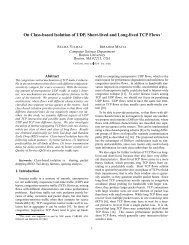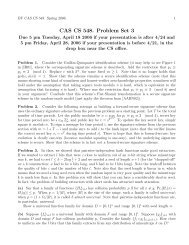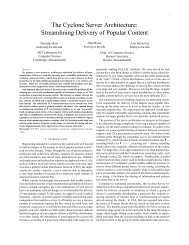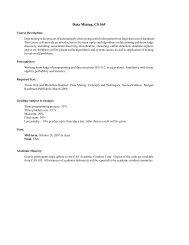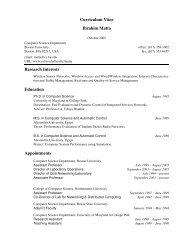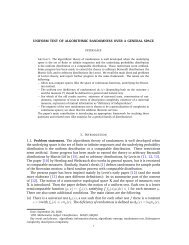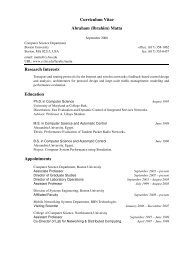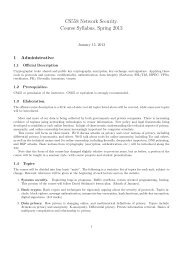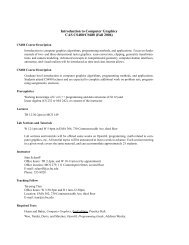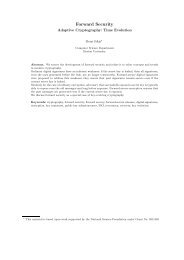Hashing Methods for Temporal Data - Computer Science - Boston ...
Hashing Methods for Temporal Data - Computer Science - Boston ...
Hashing Methods for Temporal Data - Computer Science - Boston ...
You also want an ePaper? Increase the reach of your titles
YUMPU automatically turns print PDFs into web optimized ePapers that Google loves.
KOLLIOS AND TSOTRAS: HASHING METHODS FOR TEMPORAL DATA 7<br />
where jS…t†j and jb…t†j denote the size of the evolving set S<br />
and the number of buckets used at t clearly, b…t† jb total j).<br />
A good ephemeral linear hashing scheme will try to equally<br />
distribute the oids among buckets <strong>for</strong> each t. Hence,on<br />
average,the size in oids) of each bucket b j …t† will satisfy<br />
jb j …t†j j…S…t††j=jb…t†j.<br />
One of the advantages of the Snapshot Index is the ability<br />
to tune its per<strong>for</strong>mance through usefulness parameter u. The<br />
index will distribute the oids of each b j …t† among a number of<br />
useful pages. Since each useful page except the acceptor<br />
page) contains at least uB alive oids,the oids in b j …t† will be<br />
occupying at most jb j …t†j=uB j…S…t††j=uBjb…t†j ˆ l…t†=u<br />
pages. Ideally,we would like the answer to a snapshot query<br />
to be contained in a single page. Then,a good optimization<br />
choice is to maintain l=u < 1. Conceptually,load l<br />
gives a measure of the size of a bucket ªaliveº oids) at each<br />
time. These alive oids are stored in the data pages of the<br />
Snapshot Index. Recall that an artificial copy happens if the<br />
number of alive oids in a data page falls below uB. At that<br />
point,the remaining uB 1 alive oids of this page are<br />
copied to a new page. By keeping l below u we expect that<br />
the alive oids of the split page will be copied in a single<br />
page which minimizes the number of I/Os needed <strong>for</strong><br />
finding them.<br />
On the other hand,the usefulness parameter u affects the<br />
space used by the Snapshot Index and in return the overall<br />
space of the persistent hashing scheme. Higher values of u<br />
imply frequent time splits,i.e.,more page copies and,thus,<br />
more space. Hence,it would be advantageous to keep u low<br />
but this implies an even lower l. In return,lower l would<br />
mean that the buckets of the ephemeral hashing are not<br />
fully utilized. This is because low l causes set S…t† to be<br />
distributed into more buckets,not all of which may be fully<br />
occupied.<br />
At first,this requirement seems contradictory. However,<br />
<strong>for</strong> the purposes of partially persistent linear hashing,<br />
having low l is still acceptable. Recall that the low l applies<br />
to the ephemeral hashing scheme whose history the<br />
partially persistent hashing observes and accumulates.<br />
Even though at single time instants the b j …t†s may not be<br />
fully utilized,over the whole time evolution many object<br />
oids are mapped to the same bucket. What counts <strong>for</strong> the<br />
partially persistent scheme is the total number of changes<br />
accumulated per bucket. Because of bucket reuse,a bucket<br />
will gather many changes creating a large history <strong>for</strong> the<br />
bucket and,thus,justifying its use in the partially persistent<br />
scheme. Our findings regarding optimization will be<br />
verified through the experimentation results that appear<br />
in Section 4.<br />
3.2 The Evolving-List Approach<br />
The elements of bucket b j …t† can also be viewed as an<br />
evolving list lb j …t† of alive oids. Such an observation is<br />
consistent with the way buckets are searched in ephemeral<br />
hashing,i.e.,linearly,as if a bucket's contents belong to a<br />
list. Accessing the bucket state b j …t† is then reduced to<br />
reconstructing lb j …t†. Equivalently,the evolving list of oids<br />
should be made partially persistent.<br />
We note that [39] presents a notion of persistent lists<br />
called the C-lists. A C-list is a list structure made up of a<br />
collection of pages that contain temporal versions of data<br />
records clustered by oid. However,a C-list and a partiallypersistent<br />
list solve different problems: 1) A C-list addresses<br />
the query: ªGiven an oid and a time interval,find all<br />
versions of this oid during this interval.º Instead,a partially<br />
persistent list finds all the oids that its ephemeral list had at<br />
a given time instant. 2) In a C-list,the various temporal<br />
versions of an oid must be clustered together. This implies<br />
that oids are also ordered by key. In contrast,a persistent<br />
list does not require ordering its keys,simply because its<br />
ephemeral list is not ordered. 3) In a C-list,updates and<br />
queries are per<strong>for</strong>med by first using the MVAS structure.<br />
Updating/querying the partially persistent list always<br />
starts from the top of the list and proceeds through a linear<br />
search.<br />
For the evolving-list approach,a list page has now two<br />
areas. The first area is used <strong>for</strong> storing oid records and its<br />
size is B r B r is O…B†). The second area,of size B-B r B-B r is<br />
also O…B†),accommodates an extra structure array NT),<br />
which will be explained shortly. When the first oid k is<br />
added on bucket b j at time t,a record is<br />
appended in the first list page. Additional oid insertions<br />
will create record insertions in this page. When the B r part<br />
of the first page gets full of records,a new page is appended<br />
in the list and so on. If oid k is deleted at t 0 from the bucket,<br />
its record in the list is found by a serial search among the<br />
list pages and its end_time is updated.<br />
Good clustering is achieved if each page in lb j …t† is a<br />
useful page. A page is useful if 1) it is full of records and<br />
contains at least uB r alive records …0 ,where pid is the<br />
address of the first page. When the first page of the list<br />
changes,a new entry is appended in FT j . This array can be<br />
implemented as a multilevel index since entries are added<br />
in increasing time order. Each remaining page of lb j …t† is<br />
found by the second structure,which is an array of size<br />
B-B r ,implemented inside every list page. Let NT…A† be the<br />
array inside page A. This array is maintained <strong>for</strong> as long as<br />
the page is useful. Entries in NT…A† are also of the <strong>for</strong>m<br />
,where pid corresponds to the address of the<br />
next list page after page A.<br />
To answer a temporal membership query <strong>for</strong> oid k at<br />
time t the appropriate bucket b j ,where oid k would have<br />
been mapped by the hashing scheme at t is found. This part<br />
is the same with the evolving-set approach. To reconstruct<br />
bucket b j …t†,the first page in lb j …t† is retrieved by searching t<br />
in array FT j . This search is O…log B …n j =B††. The remaining<br />
pages of lb j …t† are found by locating t in the NT array of<br />
each subsequent list page. Since all pages in the list lb j …t† are<br />
useful,the oids in b j …t† are found in O…jb j …t†j=B† I/Os.<br />
Hence,the space used by the evolving-list approach is<br />
O…n=B† while updating is O…jb t …t†j=B† per update <strong>for</strong><br />
details,see the Appendix).





